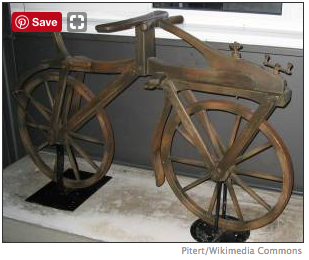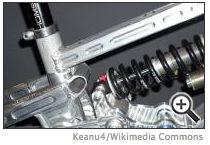Bicycles have been around for many years and are constantly being researched and improved. Many disciplines of science and engineering are necessary in making the bicycle what it is today and will be in the future. Since the appearance of the first bicycle in the late 1700s, this machine has evolved from a simple wooden contraption with two wheels and a seat to a complex, metallic-alloy vehicle made of numerous components. By analyzing the technology involved in its creation, modification, and evolution, one may obtain a better understanding of the tremendous role engineering plays in this everyday apparatus.
Introduction
Bicycles have existed for over two hundred years, and most of us have ridden one at some point during their lifetime. Over the last two centuries, bicycles have evolved at a rapid pace, from the original, simple wooden contraption of the past to the high-tech, ergonomic machines of today. Engineers have developed several elements, without which today’s bicycles could not operate as they do, such as steering mechanisms, pedaling systems with gears and a chain, brakes, and pneumatic tires. Without these major building blocks, bikes would be unfit for use. Moreover, they might be hazardous for those on or near the bicycle, and completely obsolete next to other motor-run vehicles.
Running Machines
The first bicycle was fashioned in 1791 by the Count de Sivrac of France. His bicycle was called a cheval de bois, or “wooden horse” in French. This invention consisted of two similar-sized wheels, each attached to a fork. The two forks were connected to a bar, which had a seat fastened to it. Except for various nuts and bolts, the entire device was made of wood. It had no steering mechanism or brakes– in order to make it move, the rider had to push it along with his feet. Despite these flaws, this simple bicycle caught on quickly over the next 26 years, as people made it look stylish by carving designs and staining or painting the wood.

In 1817, a prominent German citizen named Baron Karl Friedrich von Drais created a bicycle, then called a velocipede, with a steering device (see Fig. 1). This apparatus was constructed by attaching the front wheel to the bike with a crude hinge, then connecting a wooden rod to the wheel via a second fork. Velocipedestrians, or cyclists, could control their direction. Drais’s bicycle, known as the Draisine, also had a stomach brace so the rider had more support when pushing the bike along.
Pedals, Brakes and Gears
Over the next 50 years, the velocipede became more and more popular in Europe and spread to North America and Asia; however, those bicycles had no pedals, so they were originally only as fast as the rider could run – at best 10 miles per hour, downhill with the wind at one’s back. In 1865, a Frenchman, Ernest Michaux, added pedals by attaching two rods with nails on the ends to the axle of the front wheel – this contraption was now called the Michaudine. Since there were no gears or cranks, each pedal revolution caused the bike to move a distance equal to the circumference of the wheel. To increase the distance traveled for each pedal revolution, the size of the front wheel was increased. However, the size of the rear wheel was either kept constant or decreased, thus letting the rider reach the seat from the ground. From the time of this innovation until the late 1870s, when the bicycle chain came into use, most, if not all, bikes had front wheels that were much larger than those in the rear.
Now that bikes could turn and had pedals, they became more maneuverable and increased in speed. However, problems still remained: due to the large front wheels, how was a rider going to stop without crashing or falling off? A braking system had to be developed. Two years after creating pedals, Michaux added an iron pad to the Michaudine near the rear wheel that was triggered by a cable connected to a rod attached to the bike’s handlebars, much like the hand brakes on today’s bikes. When the rod was squeezed, the pad rubbed against the wheels, creating enough friction to slow and eventually stop the bike.
Because bicycles could now be stopped at will, people no longer had a fear of losing control – people now wanted bikes that traveled faster and farther, with less effort. At this time, the front wheels of most bicycles were about 60 inches in diameter; for every pedal revolution, the bike would move about 188 inches, or 16 feet. That meant a rider had to pump his legs at a rate of 110 revolutions per minute (rpm) to go a mere 20 miles per hour. At 110 rpm, most people’s legs would tire out in seconds, if they could even go that fast, since bikes weighed over thirty pounds at that time.
The only way to decrease the revolutions per minute was to implement gears and gear ratios. Linked gears rotate with the same angular velocity; consequently, a rider whose pedals crank a small gear connected to a larger gear that powers the wheels can create higher velocities. For example, pedals attached to a gear with a diameter of 8 inches connected to a wheel with a diameter of 26 inches, the standard size for most of today’s bikes, yield a gear ratio of 3.25 to 1. In such a case, a person pedaling at a rate of just 50 rpm moves the bicycle at a velocity of 93 mph. Since the average person has no need to go this fast, one can reduce the pedaling rate to 10 rpm and ride comfortably 18 miles per hour.
The inventor of the first bike with a modern chain goes unrecognized because many people in various countries claimed this distinction in the late 1870s [1]. However, in 1821, an Englishman named Louis Gompertz created a type of gear rope that functions much like the gear chains of today – this chain allows the two gears to be connected without being right next to each other.
Modern-day chains consist of four main parts: a hinge, an outer pair of parallel metal plates, and an inner metal plate. The hinge consists of a metal pin and roller that connect the inner plates to the outer plates. When these parts are assembled properly, they create a chain that allows cyclists to maximize the forward velocity generated by each pedal cycle. Pedals positioned directly below the rider are more ergonomically efficient, in contrast to the previous positioning directly upon the front tire.
Tires
After such improvements, the remaining bike problems involved wheel characteristics. Though riders crossed smooth, dry ground with ease, a muddy surface would quickly exhaust the cyclist– the wheels would either sink or “spin out” in the muck.
Additionally, an unseen rock could cause the bike to suddenly halt and send its passenger sailing over the handlebars. In 1887, John Dunlop invented a pneumatic rubber tire by filling a tube made of vulcanized rubber with air [1]. The process of vulcanization was discovered by Charles Goodyear, and it treats rubber with sulfur and other chemicals to make it stronger, more elastic, and more resistant to heat and cold. Dunlop’s development resulted in bicycles that could absorb some of the impact that occurs when traversing an imperfect landscape.
Modern Innovations
By the late 1800s, the bicycle’s basic model was very similar to what we have today. Since then, the purpose of every major technological advancement has been the improvement of the durability, comfort, speed, and/or efficiency of the bike’s overall performance and design. Recent studies concentrate on factors that contribute to these enhancements in the fabrication of materials, shock absorption, and gearing.
Materials Science
Since the force required to move an object is directly proportional to the object’s mass, a lighter bicycle has the potential for greater speed. During the past hundred years, scientists and engineers studied different substances, striving to find ones that were the most lightweight but did not sacrifice strength.

Over the years, bikes have been composed of many different materials, such as wood, iron, aluminum, titanium, or combinations and alloys of these elements. Wooden bikes were extremely heavy and did not withstand the everyday stresses of outdoor use. Over a relatively short timespan, wood rots due to air moisture, thus losing its structural integrity. Moreover, wood is soft; each minor collision causes the wooden bike to weaken. As metal-working developed, inventors began to use iron and steel to construct bicycles in the hopes of creating a more damage-resistant bike. As early as 1868, companies used iron in conjunction with casting technologies to create hollow metal bikes with hollow wheels. This reduced the weight of the average bikes to about 22 pounds.
More recently, manufacturers have employed aluminum and titanium alloys in the production of bicycles. Race Face Components, Inc., uses aluminum and carbon composites to create the crank, or pedaling mechanism [2]. Because aluminum is one of the lighter, more abundant elements found in nature, its use makes bikes more affordable and much lighter (see Fig. 2). Titanium, another light but durable metal, has been used to produce bicycle frames that weigh as little as 2.5 pounds, resulting in the manufacturing of bikes that weigh as little as 13.9 pounds. However, titanium costs about $15-$19 per foot of tubing, whereas steel has a price of only 75 cents [3]. Therefore, when titanium is used in bicycles, it is usually mixed with aluminum and/or steel to produce a slightly heavier but much less expensive frame.
Suspension
An improvement in bicycle technology over the last ten years has been the increased use of suspension systems, like those in automobiles, which are “designed to optimize a mountain-bike rider’s power and performance, while offering added speed, control, and comfort” [4]. Currently, bikes can have both front and rear suspension systems that weigh only about 3 pounds. These allow the bike, instead of the rider, to absorb force from impacts. However, shocks can be detrimental in uphill riding – they may dissipate the force a biker puts into traveling forward. In response to this, engineers have created a device through which shocks can be locked by the simple push of a button during ascent [5].
Gearing
Gear systems allow riders to change the gear ratio of the bike to account for ascents, descents, and even wind. When riding up an incline or against the wind, a rider wants the pedals to be easier to turn in order to compensate for gravity and wind pushing against him, so he would decrease the gear ratio. On the other hand, when riding downhill or with the wind, a rider wants the pedals to be harder to turn so he can use gravity and the wind to his advantage. In the latter scenario, the rider would increase the gear ratio.
The most common system of gears involves a front and rear derailleur and sets of gears, in the front (pedal area) and the rear (wheel area). The rear derailleur is responsible for moving the chain to the different rear gears, or sprockets, and keeping the chain tight. The front derailleur moves the chain among the front sprockets. Both derailleurs are controlled by cables that go from each derailleur to a shifter, usually located on the handlebars. When a shifter is turned, it moves its respective derailleur, which then guides the chain to the appropriate sprocket. The highest gear ratio, used for descents, occurs when the chain is on the biggest gear in the front and the smallest gear in the front. The lowest gear ratio, used during ascents, occurs when the chain rests on the largest rear sprocket and the smallest front sprocket.
Conclusion
Although bicycles are fundamentally simple machines, much research and development go into its basic structural design as well as the accessorized improvements that make it as efficient as possible. The original bicycle was nothing more than two wooden wheels linked with another piece of wood. Over time, though, engineers were able to design more sophisticated bicycles that featured steering mechanisms, pedaling systems, brakes, and pneumatic tires. These innovations have allowed bicycles to become high-speed vehicles that can travel in places that most automobiles cannot, with a little effort from the rider. This makes them a cost-effective means of travel for appropriate distances. Though bicycles are not always suitable for long distances, the improvements engineers have made to bicycles make for a safe, fun, and inexpensive way to travel.
References
- [1] F. Galbiati and N. Ciravegna. “Bicycles (Le Biciclette).” San Francisco: Chronicle, 1994.
- [2] K. Medina. “Aluminum/carbon fibers team up.” Modern Metals, pp. 87, Jan. 2000.
- [3] “Titanium metalworking opens new roads.” Manufacturing Engineering, pp. 126, Jul. 1998.
- [4] G. Chamberlain. “Shocker of an Idea.” Design News. pp. 90-2, Apr. 6, 1998.
- [5] J. Lewis. “Lock that shock, but make it painless.” Design News, pp. 60-3, Feb. 5, 2001.




